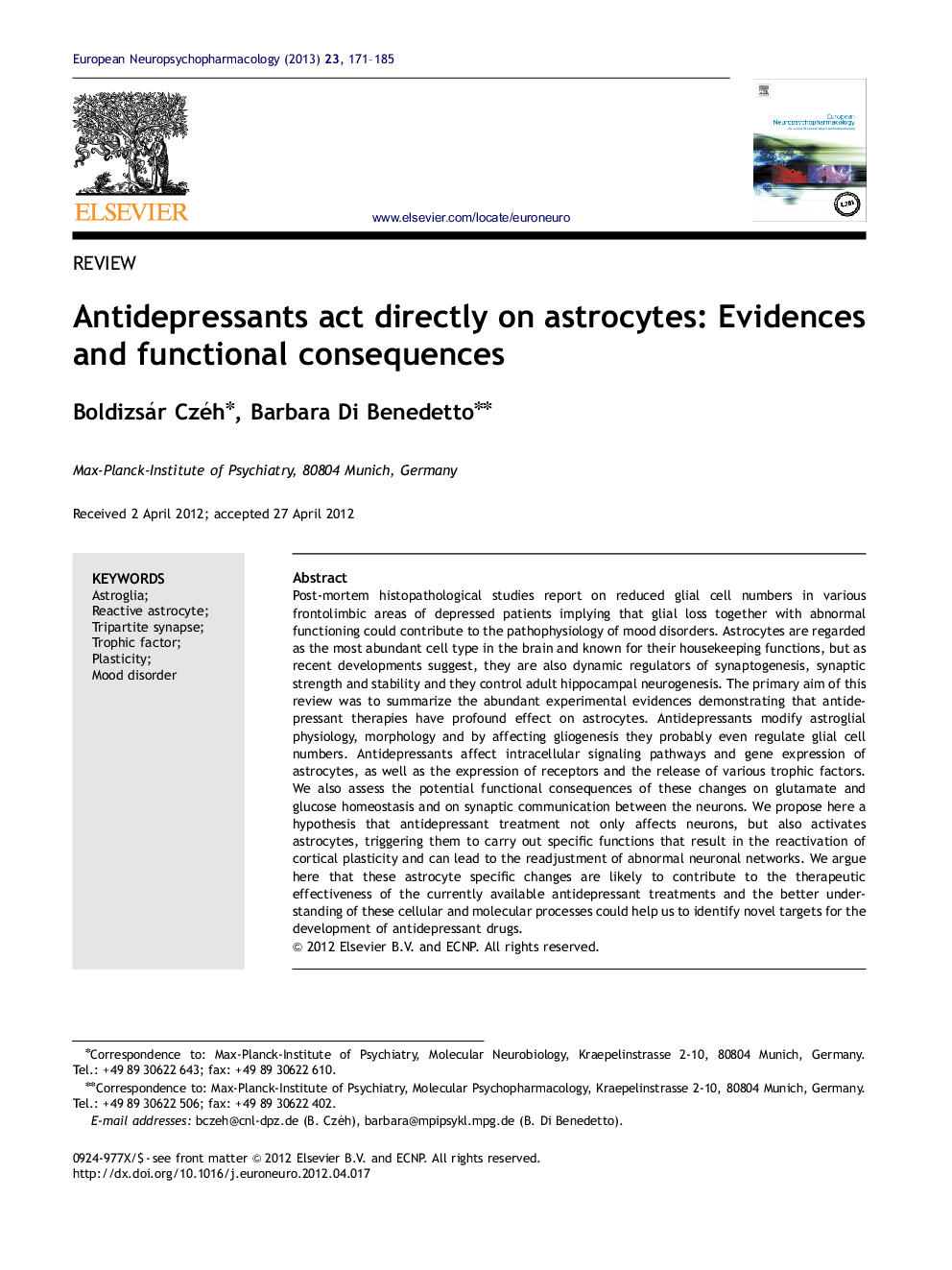| کد مقاله | کد نشریه | سال انتشار | مقاله انگلیسی | نسخه تمام متن |
|---|---|---|---|---|
| 10298203 | 539154 | 2013 | 15 صفحه PDF | دانلود رایگان |
عنوان انگلیسی مقاله ISI
Antidepressants act directly on astrocytes: Evidences and functional consequences
ترجمه فارسی عنوان
داروهای ضد افسردگی به طور مستقیم بر روی آستروسیت ها عمل می کنند: شواهد و پیامدهای عملکردی
دانلود مقاله + سفارش ترجمه
دانلود مقاله ISI انگلیسی
رایگان برای ایرانیان
کلمات کلیدی
ترجمه چکیده
مطالعات هیستوپاتولوژیک پس از مرگ گزارش می دهند که تعداد سلول های گلیال در مناطق مختلف متخلخل مبتلا به افسردگی گزارش شده است و این بدان معنی است که از دست دادن گلیال همراه با عملکرد غیر طبیعی می تواند به پاتوفیزیولوژی اختلالات خلقی کمک کند. استروسیتها به عنوان نوع سلولی فراوان در مغز شناخته شده و به خاطر عملکرد آنها در خانه شناخته می شوند، اما به گفته تحولات اخیر، آنها همچنین تنظیم کننده های پویا سیناپتوزی، قدرت سیناپسی و ثبات هستند و آنها کنترل نوروژنز بالغ هیپوکامپ را کنترل می کنند. هدف اصلی این بررسی خلاصه ای از شواهد تجربی فراوان است که نشان می دهد درمان های ضد افسردگی تاثیر زیادی بر آستروسیت ها دارند. داروهای ضد افسردگی فیزیولوژی، مورفولوژی و با تأثیر گلیوژنز را تغییر می دهند و احتمالا حتی تعداد سلول های گلیال را تنظیم می کنند. داروهای ضد افسردگی مسیرهای سیگنالینگ داخل سلولی را تحت تاثیر قرار می دهند و بیان ژن آستروسیت ها، و همچنین بیان گیرنده ها و انتشار عوامل مختلف تنفسی. ما همچنین عواقب عملکرد بالقوه این تغییرات را بر گلوتامات و هوموستاز گلوکز و ارتباطات سیناپسی بین نورون ها ارزیابی می کنیم. در اینجا فرضیه ای مطرح می شود که درمان ضد افسردگی نه تنها نورون ها را تحت تاثیر قرار می دهد، بلکه باعث فعال شدن آستروسیت ها می شود که آنها را قادر می سازد تا توابع خاصی را ایجاد کنند که منجر به فعال شدن انعطاف پذیری قشر می شود و می تواند منجر به تعدیل شبکه های عصبی غیر طبیعی شود. ما در اینجا استدلال می کنیم که این تغییرات آستروستیستی احتمالا به تأثیرات درمانی درمان های ضد افسردگی در حال حاضر کمک می کند و درک بهتر این فرآیندهای سلولی و مولکولی می تواند به ما در شناسایی اهداف جدید برای توسعه داروهای ضد افسردگی کمک کند.
موضوعات مرتبط
علوم زیستی و بیوفناوری
علم عصب شناسی
روانپزشکی بیولوژیکی
چکیده انگلیسی
Post-mortem histopathological studies report on reduced glial cell numbers in various frontolimbic areas of depressed patients implying that glial loss together with abnormal functioning could contribute to the pathophysiology of mood disorders. Astrocytes are regarded as the most abundant cell type in the brain and known for their housekeeping functions, but as recent developments suggest, they are also dynamic regulators of synaptogenesis, synaptic strength and stability and they control adult hippocampal neurogenesis. The primary aim of this review was to summarize the abundant experimental evidences demonstrating that antidepressant therapies have profound effect on astrocytes. Antidepressants modify astroglial physiology, morphology and by affecting gliogenesis they probably even regulate glial cell numbers. Antidepressants affect intracellular signaling pathways and gene expression of astrocytes, as well as the expression of receptors and the release of various trophic factors. We also assess the potential functional consequences of these changes on glutamate and glucose homeostasis and on synaptic communication between the neurons. We propose here a hypothesis that antidepressant treatment not only affects neurons, but also activates astrocytes, triggering them to carry out specific functions that result in the reactivation of cortical plasticity and can lead to the readjustment of abnormal neuronal networks. We argue here that these astrocyte specific changes are likely to contribute to the therapeutic effectiveness of the currently available antidepressant treatments and the better understanding of these cellular and molecular processes could help us to identify novel targets for the development of antidepressant drugs.
ناشر
Database: Elsevier - ScienceDirect (ساینس دایرکت)
Journal: European Neuropsychopharmacology - Volume 23, Issue 3, March 2013, Pages 171-185
Journal: European Neuropsychopharmacology - Volume 23, Issue 3, March 2013, Pages 171-185
نویسندگان
Boldizsár Czéh, Barbara Di Benedetto,
